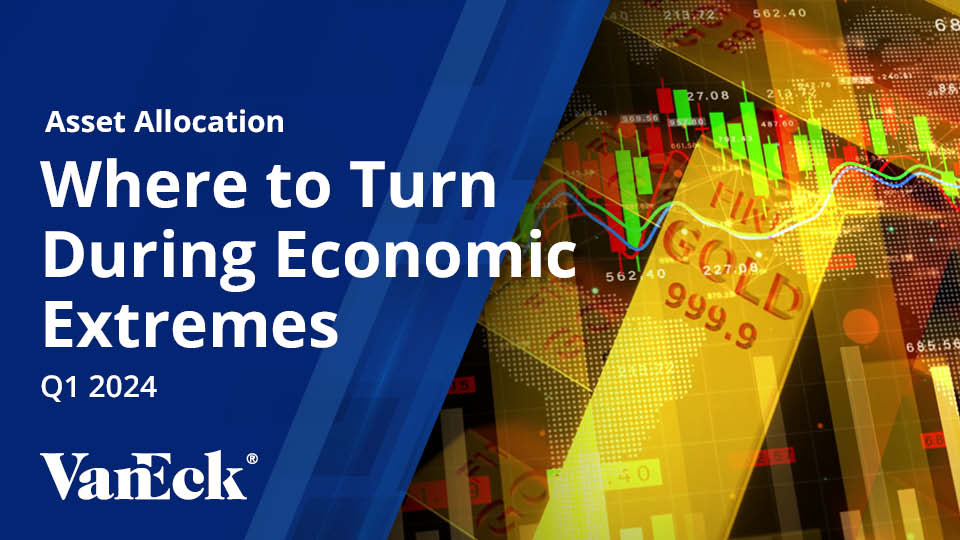Real Assets Responding to Real Inflation
June 25, 2021
Read Time 6 MIN
The VanEck Vectors® Real Asset Allocation ETF (RAAX®) uses a data-driven, rules-based process that leverages over 50 indicators (technical, macroeconomic and fundamental, commodity price, and sentiment) to allocate across 12 individual real asset segments in five broad real asset sectors. These objective indicators identify the segments with positive expected returns. Then, using correlation and volatility, an optimization process determines the weight to these segments with the goal of creating a portfolio with maximum diversification while reducing risk. The expanded PDF version of this commentary can be downloaded here.
Overview
The VanEck Vectors® Real Asset Allocation ETF (“RAAX”) returned +2.86% versus +2.73% for the Bloomberg Commodity Index. RAAX is now up 22.72% year-to-date as it continues to benefit from higher inflation. The top performing segment of the portfolio was resource assets, with a return of +4.47%, followed by income assets with a return of +1.69%. Financial assets lagged the others, with a return of +0.76%.
The latest consumer price index (CPI) numbers were released on June 10, and confirmed what everyone is experiencing—prices are rising! The CPI increased by +0.60% in May, which brings the 12-month increase to 5.00%. The largest increase was in used cars and trucks with an increase of 7.30%, which followed the 10.00% increase in April. Used car prices are surging because of shortages in the materials and components needed to produce new automobiles.
We are keeping a close eye on the cost of shelter, or housing costs. It is the largest component of the CPI and it has been steadily rising since February. Shelter is measured by rent levels, as opposed to home prices, because rents are much less volatile than home sale prices. Below is a chart of S&P Case-Shiller U.S. National Home Price Index. It shows that home prices have exploded to the upside. Eventually, rental rates should catch up and be reflected in the CPI.
S&P Case - Shiller U.S. National Home Price Index
(6/11/2016 - 3/31/2021)
Data as of March 31, 2021. Source: Bloomberg. Past performance does not guarantee future results. Please see index descriptions in disclosure.
There is some anecdotal evidence of wage inflation. Walmart and Amazon, the two largest employers in the U.S., will raise wages to attract and retain employees. Chipotle is charging 4% more for burritos to cover higher wages. The National Owners Association, an independent group of McDonald’s franchisees, suggests that higher pay and higher prices are on the menu. One franchise owner is offering $50 to anyone who sits for an interview.
Gold had started to respond to higher inflation, but has stumbled in recent days. Typically, gold responds later in the inflation cycle once the problem is undeniable and investors flock to the precious metal as a store of value. The chart below demonstrates the price of gold relative to inflation expectations.
Gold and Inflation Expectations (as of May 31, 2021)
Data as of Mary 31, 2021. Source: Bloomberg. Past performance does not guarantee future results. Please see index description in disclosure.
RAAX continues to be positioned for higher commodity prices with a nearly 50% allocation to resource assets. Income producing real assets account for approximately 30% and financial real assets account for approximately 20%.
RAAX Asset Allocation Across Financial, Income, and Resource Assets (as of June 1, 2021)
Source: VanEck.
Performance Review
The largest contributors to performance, from largest to smallest, were resource assets with a return of +2.10%, income assets with a return of +0.61% and financial assets, with a return of +0.20%.
Total Return Contribution (May 2021)
Data as of May 31, 2021. Source: FactSet. Past performance does not guarantee future results.
The resource assets segment of the portfolio returned +4.47% in May and +23.93% year-to-date. RAAX’s holdings in natural resource equities, in aggregate, were up 4.85% and its commodity exposure returned +3.92%.
Within natural resource equities, the top performing sectors were traditional energy equities, up 9.75%, and base metal equities, up 5.32%. The bottom performing natural resource equity segments were renewable energy, which lost 2.66%, and agribusiness equities, which returned +1.65%. The top performing commodities were gold, up 7.61%, oil, up 4.47%, and copper, up 4.45%. The agriculture commodities lagged, with corn and wheat returning -3.24% and -5.25%, respectively.
Resource Assets: Total Return and Contribution (May 2021)
Data as of May 31, 2021. Source: FactSet. Past performance does not guarantee future results.
Income-Producing Assets
The income-producing assets are yielding 2.73% based on 12-month yields. This segment of the portfolio returned +1.97% in May and +20.05% year-to-date. The yield of the U.S. 10-Year Treasury note started the month at 1.63%, briefly rose to 1.69%, and finished the month near where it began, at 1.59%. The stability in interest rates was a positive for the income-producing real assets. MLPs, which benefited from higher oil prices, were the top performing real asset with a return of +4.80%. RAAX’s infrastructure investments, in aggregate, returned +1.65%. U.S. infrastructure outperformed global infrastructure by 1.86%. REITs were the laggard with a return of +0.81%.
Income Assets: Total Return and Contribution (May 2021)
Data as of May 31, 2021. Source: FactSet. Past performance does not guarantee future results.
Financial Assets
The financial assets, in aggregate, returned +0.76% in May and have returned -2.38% year-to-date. The financial assets segment of the portfolio is largely comprised of gold bullion and gold equities, which returned +7.63% and +14.73%, respectively. Gold was a top performer due to concerns over inflation and the falling U.S. dollar. Bitcoin had a terrible month. It started May at $56,814 and ended the month at $36,690. The rapid reversal in bitcoin was due to energy consumption concerns related to mining new coins and the threat of increased regulations. The weight of bitcoin was reduced in early- and mid-May due to the significant increase in volatility of the asset lately. As of June, the weighting to bitcoin is approximately 2%.
Financial Assets: Total Return and Contribution (May 2021)
Data as of May 31, 2021. Source: FactSet. Past performance does not guarantee future results.
The table below demonstrates the current and previous month’s asset allocation for RAAX. There were no changes to the asset allocation in June. The current allocations are below:
Monthly Asset Class Changes
| Jun-21 | May-21 | Change | |
| Financial Assets | 20.3% | 22.3% | -2.0% |
| Bitcoin | 2.1% | 4.5% | -2.4% |
| Gold Equities | 4.7% | 4.5% | 0.1% |
| Gold Bullion | 13.6% | 13.2% | 0.3% |
| Income Assets | 29.7% | 30.2% | -0.5% |
| REITs | 13.5% | 14.9% | -1.4% |
| MLPs | 5.9% | 5.6% | 0.3% |
| Global Infrastructure | 10.4% | 9.8% | 0.6% |
| Resource Assets | 49.0% | 47.3% | 1.6% |
| Low Carbon Energy Equities | 4.7% | 4.9% | -0.2% |
| Diversified Commodities | 19.9% | 19.7% | 0.2% |
| Global Metals & Mining Equities | 3.4% | 3.3% | 0.2% |
| Steel Equities | 3.7% | 3.5% | 0.3% |
| Unconventional Oil & Gas Equities | 3.9% | 3.4% | 0.4% |
| Oil Services Equities | 3.5% | 3.0% | 0.5% |
| Energy Equities | 4.7% | 4.4% | 0.3% |
| Agribusiness Equities | 5.2% | 5.2% | 0.0% |
| Cash | 0.2% | 0.1% | 0.0% |
Source: VanEck.
The chart below shows the real asset risk composite that measures extreme risk within real assets using various quantitative signals. The current score is 2.17, which indicates a stable risk regime for real assets.
Overall Risk Score
Source: VanEck.
So far, 2021 has been a strong year for real asset investors. High commodity prices have led to the strong performance of natural resource equities. U.S. infrastructure, MLPs and REITs have also been strong performers. Now, gold, which has largely been left behind in 2021, is attempting to catch up as inflation expectations rise. If gold does continue to rally from here, it will greatly benefit RAAX given the fund’s nearly 20% allocation to the shiny metal.
Related Topics
Related Insights
February 28, 2024
February 22, 2024
December 19, 2023
IMPORTANT DISCLOSURES
CPI – US CPI Urban Consumers YoY NSA Index measures US consumer prices (CPI) as a measure of prices paid by consumers for a market basket of consumer goods and services. The yearly (or monthly) growth rates represent the inflation rate.
Please note that the information herein represents the opinion of the author, but not necessarily those of VanEck, and these opinions may change at any time and from time to time. Non-VanEck proprietary information contained herein has been obtained from sources believed to be reliable, but not guaranteed. Not intended to be a forecast of future events, a guarantee of future results or investment advice. Historical performance is not indicative of future results. Current data may differ from data quoted. Any graphs shown herein are for illustrative purposes only. No part of this material may be reproduced in any form, or referred to in any other publication, without express written permission of VanEck.
This content is published in the United States for residents of specified countries. Investors are subject to securities and tax regulations within their applicable jurisdictions that are not addressed on this content. Nothing in this content should be considered a solicitation to buy or an offer to sell shares of any investment in any jurisdiction where the offer or solicitation would be unlawful under the securities laws of such jurisdiction, nor is it intended as investment, tax, financial, or legal advice. Investors should seek such professional advice for their particular situation and jurisdiction.
The MVIS Global Agribusiness Index is a modified market cap-weighted index tracks the performance of the largest and most liquid companies in the global agribusiness segment. Its unique pure-play approach requires that companies have to generate at least 50% of their revenues from agri-chemicals and fertilizers, seeds and traits, from farm/irrigation equipment and farm machinery, from agricultural products (incl. Grain, tobacco, meat, poultry and sugar), aquaculture and fishing, livestock, plantations and trading of agricultural products. The MVIS Global Coal Index is a modified market cap-weighted index tracks the performance of the largest and most liquid companies in the global coal segment. Its unique pure-play approach requires that companies have to generate at least 50% of their revenues from coal operation (production, mining and cokeries), transportation of coal, from production of coal mining equipment as well as from storage and trade. The NYSE Arca Gold Miners Index is a modified market capitalization-weighted index composed of publicly traded companies involved primarily in the mining for gold. The Index is calculated and maintained by the New York Stock Exchange. The MVIS U.S. Listed Oil Services 25 Index is intended to track the overall performance of U.S.-listed companies involved in oil services to the upstream oil sector, which include oil equipment, oil services, or oil drilling. The MVIS Global Unconventional Oil & Gas Index is intended to track the performance of the largest and most liquid companies in the unconventional oil and gas segment. The pure-play index contains only companies that generate at least 50% of their revenues from unconventional oil and gas which is defined as coal bed methane (CBM), coal seam gas (CSG), shale oil, shale gas, tight natural gas, tight oil and tight sands. The DBIQ Optimum Yield Diversified Commodity Index Excess Return is an index composed of futures contracts on 14 heavily traded commodities across the energy, precious metals, industrial metals and agriculture sectors. The NYSE Arca Steel Index is a modified market capitalization weighted index comprised of publicly traded companies involved primarily in the production of steel products. The S&P Global Infrastructure Index is designed to track companies from around the world chosen to represent the listed infrastructure industry while maintaining liquidity and tradability. To create diversified exposure, the index includes three distinct infrastructure clusters: energy, transportation, and utilities. The Ardour Global IndexSM Extra Liquid Index tracks a market-cap-weighted index of low carbon energy companies defined as deriving at least 50% of their revenues from alternative energy. The LBMA Gold Price Index: is a regulated benchmark administered by ICE Benchmark Administration (IBA) who provide the auction platform, the methodology and the overall independent administration and governance for the LBMA Gold Price. The LBMA Gold Price continues to be set twice daily (at 10:30 and 15:00 London BST) in US dollars and other currencies. The MSCI US IMI Real Estate 25/50 Index is designed to capture the large, mid and small cap segments of the U.S. equity universe. All securities in the index are classified in the Real Estate sector as per the Global Industry Classification Standard (GICS®). The index also applies certain investment limits to help ensure diversification. The Energy Sector Index seeks to provide an effective representation of the energy sector of the S&P 500 Index. The Index includes companies from the following industries: oil, gas and consumable fuels; and energy equipment and services. The MSCI ACWI Select Metals & Mining Producers Ex Gold and Silver Investable Market Index (IMI) aims to focus on companies in the industrial and rare earth metals (excluding gold and silver) that are highly sensitive to underlying prices of industrial and rare earth metals. The index includes companies that are primarily engaged in the production or extraction of metals and minerals, in the mining of precious metals excluding gold and silver (e.g. platinum), or in the production of aluminum or steel.
Any indices listed are unmanaged indices and include the reinvestment of all dividends, but do not reflect the payment of transaction costs, advisory fees or expenses that are associated with an investment in the Fund. Certain indices may take into account withholding taxes. An index’s performance is not illustrative of the Fund’s performance. Indices are not securities in which investments can be made.
An investment in the Fund may be subject to risks which include, among others, in fund of funds risk which may subject the Fund to investing in commodities, gold, natural resources companies, MLPs, real estate sector, infrastructure, equities securities, small- and medium-capitalization companies, foreign securities, emerging market issuers, foreign currency, credit, interest rate, call and concentration risks, derivatives, cryptocurrency, cryptocurrency tax, all of which may adversely affect the Fund. The Fund may also be subject to affiliated fund, U.S. Treasury Bills, subsidiary investment, commodity regulatory (with respect to investments in the Subsidiary), tax (with respect to investments in the Subsidiary), risks of ETPs, liquidity, gap, cash transactions, high portfolio turnover, model and data, management, operational, authorized participant concentration, no guarantee of active trading market, trading issues, market, fund shares trading, premium/discount and liquidity of fund shares, and non-diversified risks. Foreign investments are subject to risks, which include changes in economic and political conditions, foreign currency fluctuations, changes in foreign regulations, and changes in currency exchange rates which may negatively impact the Fund’s returns. Small- and medium-capitalization companies may be subject to elevated risks.
Diversification does not assure a profit or protect against a loss.
Investing involves substantial risk and high volatility, including possible loss of principal. Bonds and bond funds will decrease in value as interest rates rise. An investor should consider the investment objective, risks, charges and expenses of the Fund carefully before investing. To obtain a prospectus and summary prospectus, which contains this and other information, call 800.826.2333 or visit vaneck.com. Please read the prospectus and summary prospectus carefully before investing.
© VanEck.
Related Funds
IMPORTANT DISCLOSURES
CPI – US CPI Urban Consumers YoY NSA Index measures US consumer prices (CPI) as a measure of prices paid by consumers for a market basket of consumer goods and services. The yearly (or monthly) growth rates represent the inflation rate.
Please note that the information herein represents the opinion of the author, but not necessarily those of VanEck, and these opinions may change at any time and from time to time. Non-VanEck proprietary information contained herein has been obtained from sources believed to be reliable, but not guaranteed. Not intended to be a forecast of future events, a guarantee of future results or investment advice. Historical performance is not indicative of future results. Current data may differ from data quoted. Any graphs shown herein are for illustrative purposes only. No part of this material may be reproduced in any form, or referred to in any other publication, without express written permission of VanEck.
This content is published in the United States for residents of specified countries. Investors are subject to securities and tax regulations within their applicable jurisdictions that are not addressed on this content. Nothing in this content should be considered a solicitation to buy or an offer to sell shares of any investment in any jurisdiction where the offer or solicitation would be unlawful under the securities laws of such jurisdiction, nor is it intended as investment, tax, financial, or legal advice. Investors should seek such professional advice for their particular situation and jurisdiction.
The MVIS Global Agribusiness Index is a modified market cap-weighted index tracks the performance of the largest and most liquid companies in the global agribusiness segment. Its unique pure-play approach requires that companies have to generate at least 50% of their revenues from agri-chemicals and fertilizers, seeds and traits, from farm/irrigation equipment and farm machinery, from agricultural products (incl. Grain, tobacco, meat, poultry and sugar), aquaculture and fishing, livestock, plantations and trading of agricultural products. The MVIS Global Coal Index is a modified market cap-weighted index tracks the performance of the largest and most liquid companies in the global coal segment. Its unique pure-play approach requires that companies have to generate at least 50% of their revenues from coal operation (production, mining and cokeries), transportation of coal, from production of coal mining equipment as well as from storage and trade. The NYSE Arca Gold Miners Index is a modified market capitalization-weighted index composed of publicly traded companies involved primarily in the mining for gold. The Index is calculated and maintained by the New York Stock Exchange. The MVIS U.S. Listed Oil Services 25 Index is intended to track the overall performance of U.S.-listed companies involved in oil services to the upstream oil sector, which include oil equipment, oil services, or oil drilling. The MVIS Global Unconventional Oil & Gas Index is intended to track the performance of the largest and most liquid companies in the unconventional oil and gas segment. The pure-play index contains only companies that generate at least 50% of their revenues from unconventional oil and gas which is defined as coal bed methane (CBM), coal seam gas (CSG), shale oil, shale gas, tight natural gas, tight oil and tight sands. The DBIQ Optimum Yield Diversified Commodity Index Excess Return is an index composed of futures contracts on 14 heavily traded commodities across the energy, precious metals, industrial metals and agriculture sectors. The NYSE Arca Steel Index is a modified market capitalization weighted index comprised of publicly traded companies involved primarily in the production of steel products. The S&P Global Infrastructure Index is designed to track companies from around the world chosen to represent the listed infrastructure industry while maintaining liquidity and tradability. To create diversified exposure, the index includes three distinct infrastructure clusters: energy, transportation, and utilities. The Ardour Global IndexSM Extra Liquid Index tracks a market-cap-weighted index of low carbon energy companies defined as deriving at least 50% of their revenues from alternative energy. The LBMA Gold Price Index: is a regulated benchmark administered by ICE Benchmark Administration (IBA) who provide the auction platform, the methodology and the overall independent administration and governance for the LBMA Gold Price. The LBMA Gold Price continues to be set twice daily (at 10:30 and 15:00 London BST) in US dollars and other currencies. The MSCI US IMI Real Estate 25/50 Index is designed to capture the large, mid and small cap segments of the U.S. equity universe. All securities in the index are classified in the Real Estate sector as per the Global Industry Classification Standard (GICS®). The index also applies certain investment limits to help ensure diversification. The Energy Sector Index seeks to provide an effective representation of the energy sector of the S&P 500 Index. The Index includes companies from the following industries: oil, gas and consumable fuels; and energy equipment and services. The MSCI ACWI Select Metals & Mining Producers Ex Gold and Silver Investable Market Index (IMI) aims to focus on companies in the industrial and rare earth metals (excluding gold and silver) that are highly sensitive to underlying prices of industrial and rare earth metals. The index includes companies that are primarily engaged in the production or extraction of metals and minerals, in the mining of precious metals excluding gold and silver (e.g. platinum), or in the production of aluminum or steel.
Any indices listed are unmanaged indices and include the reinvestment of all dividends, but do not reflect the payment of transaction costs, advisory fees or expenses that are associated with an investment in the Fund. Certain indices may take into account withholding taxes. An index’s performance is not illustrative of the Fund’s performance. Indices are not securities in which investments can be made.
An investment in the Fund may be subject to risks which include, among others, in fund of funds risk which may subject the Fund to investing in commodities, gold, natural resources companies, MLPs, real estate sector, infrastructure, equities securities, small- and medium-capitalization companies, foreign securities, emerging market issuers, foreign currency, credit, interest rate, call and concentration risks, derivatives, cryptocurrency, cryptocurrency tax, all of which may adversely affect the Fund. The Fund may also be subject to affiliated fund, U.S. Treasury Bills, subsidiary investment, commodity regulatory (with respect to investments in the Subsidiary), tax (with respect to investments in the Subsidiary), risks of ETPs, liquidity, gap, cash transactions, high portfolio turnover, model and data, management, operational, authorized participant concentration, no guarantee of active trading market, trading issues, market, fund shares trading, premium/discount and liquidity of fund shares, and non-diversified risks. Foreign investments are subject to risks, which include changes in economic and political conditions, foreign currency fluctuations, changes in foreign regulations, and changes in currency exchange rates which may negatively impact the Fund’s returns. Small- and medium-capitalization companies may be subject to elevated risks.
Diversification does not assure a profit or protect against a loss.
Investing involves substantial risk and high volatility, including possible loss of principal. Bonds and bond funds will decrease in value as interest rates rise. An investor should consider the investment objective, risks, charges and expenses of the Fund carefully before investing. To obtain a prospectus and summary prospectus, which contains this and other information, call 800.826.2333 or visit vaneck.com. Please read the prospectus and summary prospectus carefully before investing.
© VanEck.



